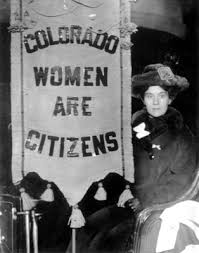
Women’s Suffrage Series
Cherry Sokoloski
“Let the women vote! They can’t do any worse than the men have!”
And with that rousing endorsement, the women of Colorado won the right to vote. It was 1893, 27 years before the 19th Amendment to the U.S. Constitution was ratified.
Colorado was not the first state where women gained full voting rights, but it was the first where the right was won by popular vote – with only men voting on the referendum, of course! Colorado women can also boast other “firsts” in the political realm. This state was the first to elect women to a state legislature in 1894 when not one but three were elected to the Colorado House. They made national news.
On a humorous note, these three pioneers had a dilemma to solve: what should they do with their hats? They finally decided to wear the hats into the House chamber, then put them on their desks. By the year 1900, there were 10 women’s hats adorning the statehouse.
Four Western states were the first to grant women full voting rights. Besides Colorado, they were Wyoming in 1890, and Utah and Idaho in 1896. With the latter three, state legislatures approved suffrage for women, as opposed to a popular vote.
Why were these Western states so far ahead of the curve? There are different theories, but one that appeals to this writer is that the Western culture of the 19th century was quite different from that of the rest of the country. In the Western frontier, women had no choice but to work alongside men in scratching out homesteads and livelihoods from a harsh environment. They were equal partners in many ways, and perhaps men recognized voting as an extension of that equality.
That said, suffrage was not an easy win in Colorado. The measure was defeated in 1877, despite campaign visits from famous suffragists Susan B. Anthony and Lucy Stone. Even in 1893, many people – including prominent national suffrage leaders – discouraged the women from going ahead with their referendum because the state was experiencing severe depression. Yet they persevered – and won with a two-thirds majority vote.
Colorado suffragists worked hard to win support among men, including the Populist governor. Among their allies were silver miners who had been laid off when the United States adopted the gold standard, and the price of silver crashed. Women activists gave direct aid to their struggling families, setting up soup kitchens and tent camps while advocating for the suffrage cause. The women also included a pro-silver plank in their platform.
The 1890s were the heyday of women’s organizations, and they served as powerful lobbying groups for the suffrage campaign. There were literary and music societies, temperance groups, neighborhood clubs, and reform organizations, besides a whopping 60 suffrage chapters. These groups became valuable training grounds for organizing and public speaking.
Journalists played a huge role in the Colorado suffrage movement. Ellis Meredith, dubbed “the Susan B. Anthony of Colorado,” wrote a woman’s column for the Rocky Mountain News and relentlessly pressed for suffrage. Minnie J. Reynolds, another RMN writer, helped win the support of 75 percent of the state’s newspapers during the 1893 campaign. Elizabeth Piper Ensley, a Black journalist from Massachusetts who had rubbed shoulders with national suffrage leaders, wrote a column for Woman’s Era and used it to gain support from the African-American community.
Molly Brown, of Titanic fame, was also a pro-suffrage journalist.
Once Colorado women had the vote, they celebrated and then got back to work. They joined all three political parties and demanded to be part of the political process. They lobbied the legislature for causes such as inheritance, child protection, the age of consent, and fair labor laws.
Coloradans also participated in the national suffrage campaign and many state campaigns. When Alice Paul and the National Woman’s Party organized the White House pickets in 1917, several women from Colorado joined the fray. Dr. Carolyn Spencer of Colorado Springs was arrested three times on the picket lines and spent seven months in the infamous Occoquan Workhouse. She was in her 60s at the time.
Interestingly, the Colorado state government paid people to register women to vote after their 1893 victory. Women’s organizations, which had been instrumental in pushing for suffrage, now educated their members about candidates, issues, and the process of voting. This activity likely provided a role model for the League of Women Voters, formed in 1919.
A footnote: Susan B. Anthony did not think women would succeed in Colorado in 1893, so she did not come to help them campaign. When Ellis Meredith attended the 1894 national suffrage meeting to tell Colorado’s success story, Anthony was quite rude. Colorado had won the vote without her help – a bit bruising for the ego!
Sources: Andrea Malcomb of the Molly Brown House Museum, historian Marcia Goldstein, Spring 1993 issue of Colorado Heritage.
Support Northern Colorado Journalism
Show your support for North Forty News by helping us produce more content. It's a kind and simple gesture that will help us continue to bring more content to you.
BONUS - Donors get a link in their receipt to sign up for our once-per-week instant text messaging alert. Get your e-copy of North Forty News the moment it is released!
Click to Donate
